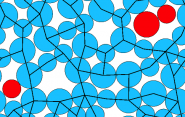A New Theory to Describe Packings of Frictional Particles

Say you’re trying to organize your glassware—an even mixture of small Japanese teacups and larger mugs—so that they fit efficiently into your cupboard. The shelves are too close together to stack the glasses, and since you use both teacups and mugs regularly, a random arrangement is convenient. So how many different ways can you pack the glasses into the cupboard so that when you push on the outermost glasses, the arrangement remains stable and does not move?

The answer, according to associate professor of mechanical engineering & materials science, physics, & applied physics Corey O’Hern, depends crucially on friction. Experimentally, scientists have long known that if the glasses are frictionless, then when you push on them, they will slide past each other until each is touching, on average, four other objects. However, if the glasses are sufficiently frictional and resist sliding, each will only touch an average of three others.
O’Hern’s most recent research, published September 15 in Physical Review Letters, is one of the first to mathematically describe this behavior, providing a theoretical model of why the average contact number drops from four to three (for systems in two spatial dimensions) at a specific friction coefficient.
“Before now, there hasn’t been a satisfactory theory that can predict the friction coefficient threshold that marks the transition from frictionless to highly frictional behavior,” says O’Hern, the co-principal investigator of the research. “The only theory that can predict such a threshold is one that actually counts or quantifies all of the possible particle packings for each value of the friction coefficient.”
The O’Hern research team also included former Yale Ph.D. student Tianqi Shen and associate research scientist Stefanos Papanikolaou, as well as City College of New York professor of physics and co-principal investigator Mark Shattuck.
To develop their theoretical model, the research team designed a computer program that can enumerate all possible packings for a given number of frictional disks within a given area. The researchers then repeated the calculations to generate billions of packings over a wide range of friction coefficients. “Scientists and mathematicians have previously guessed that frictional particles can produce an infinite number of packings, so they’d given up trying to count all of the possibilities,” says O’Hern, “But we came up with a clever scheme of classifying the infinite number of packings.”

These calculations are important because the average number of contacts determines the strength of particle packings. Packings that are more highly coordinated will generally be stronger. O’Hern’s theoretical model enables researchers to better understand the mechanical properties of frictional particle packings.
This research is one step towards O’Hern’s goal of establishing a comprehensive theoretical framework for predicting how macroscale particles—from grains of sand to coffee beans—self-assemble into large arrangements with mechanical properties that resemble, but are distinct from, what is traditionally considered a solid state. To carry out this research, O’Hern and co-investigators Bulbul Chakraborty from Brandeis University and Robert Behringer from Duke University were awarded a $1 million grant this past summer from the W.M. Keck Foundation.
“The Keck Grant will allow us to develop new experimental, computational, and theoretical methods to study macroscale assembly of particles with more realistic shapes and in 3D geometries,” says O’Hern. “By developing a theoretical model that can accurately describe packings of spherical particles, this research is the foundation for a more general model that can describe packings of nonspherical particles as well.”

